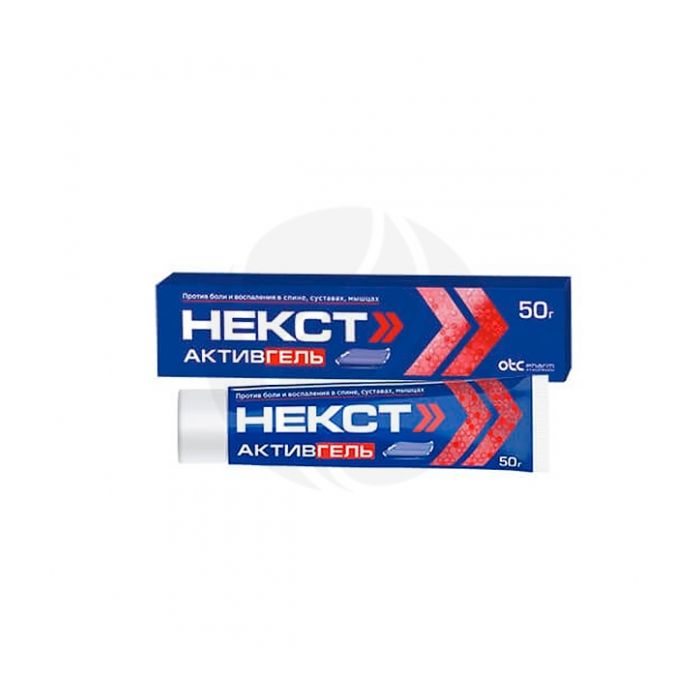Next Active gel, 50g
Expiration Date: 05/2027
Russian Pharmacy name:
Некст Актив гель , 50г
As a topical analgesic and anti-inflammatory agent for conditions such as muscle pain, back pain, arthritis, pain from ligament injuries and sprains, sports injuries and neuralgia.
The drug is intended for external use.
For adults and children from 14 years of age, a small amount of gel (a strip 3-5 cm long) is applied in a thin layer to the skin over the lesion and rubbed in with light movements.
Hands should be washed immediately after using the drug, unless they are the object of treatment.
Re-use of the drug is possible no earlier than after 4 hours. The product can be applied up to 4 times within 24 hours.
The duration of using the drug without consulting a doctor is no more than 10 days. If you need a longer use, you should consult your doctor.
Active ingredients:
ibuprofen - 50.0 mg, levomenthol - 30.0 mg
Excipients:
propylene glycol - 100.0 mg, ethanol 95% - 300.0 mg, carbomer - 20.0 mg, diisopropanolamine - 55.0 mg, water purified - up to 1000.0 mg.
Hypersensitivity to ibuprofen or to other components of the drug;
hypersensitivity to acetylsalicylic acid and other NSAIDs;
complete or incomplete combination of bronchial asthma, recurrent polyposis of the nose and paranasal sinuses and intolerance to acetylsalicylic acid or other NSAIDs (including a history);
violation of the integrity of the skin at the site of application of the drug (including infected wounds and abrasions, weeping dermatitis, eczema);
children up to age 14;
pregnancy, lactation.
Carefully
Before using the drug, it is necessary to consult a doctor in the presence of concomitant diseases of the liver and kidneys, gastrointestinal tract, exacerbation of hepatic porphyria, bronchial asthma, urticaria, rhinitis, polyps of the nasal mucosa, chronic heart failure, as well as elderly patients.
Pharmacological properties
Pharmacodynamics
NEXT ACTIVEGEL is a combination of two active substances - ibuprofen and levomenthol.
Ibuprofen is a non-steroidal anti-inflammatory agent derived from propionic acid that indiscriminately blocks the enzymes cyclooxygenase 1 (COX-1) and cyclooxygenase 2 (COX-2), as a result of which it inhibits the synthesis of prostaglandins - mediators of pain, inflammation and hyperthermic reaction. When applied topically, ibuprofen has analgesic and anti-inflammatory effects.
Levomenthol has a local irritating effect, which leads to the rapid development of the analgesic effect of the drug.
The combination of ibuprofen and levomenthol reduces pain and inflammation, is effective for joint pain during movement and at rest, and reduces morning stiffness of the joints.
Pharmacokinetics
After application to the skin, ibuprofen is found in the epidermis and dermis after 24 hours. Reaches a high therapeutic concentration in the underlying soft tissues, joints and synovial fluid. Virtually no clinically significant systemic absorption occurs. The maximum concentration of ibuprofen in the blood plasma for topical application is 5% of the maximum concentration for oral administration of ibuprofen. Ibuprofen is metabolized in the liver. It is excreted by the kidneys (not more than 1% unchanged) and, to a lesser extent, with bile through the intestines.
Application during pregnancy and during breastfeeding
The use of the drug during pregnancy and during breastfeeding is contraindicated.
If necessary, the use of the drug during lactation should stop breastfeeding.
Side effect
- Violations of the immune system
Frequency unknown: hypersensitivity reactions (nonspecific allergic reactions and anaphylactic reactions), reactions from the respiratory tract (bronchial asthma, including its exacerbation, bronchospasm, shortness of breath, dyspnea), skin reactions (pruritus, urticaria , purpura, exfoliative and bullous dermatoses, including toxic epidermal necrolysis (Lyell's syndrome), Stevens-Johnson syndrome, erythema multiforme, eczema, photosensitization), Quincke's edema.
- Disorders from the gastrointestinal tract
Frequency unknown: abdominal pain, dyspepsia.
- Disorders of the kidneys and urinary tract.
Frequency unknown: impaired renal function.
With prolonged use, the development of systemic side effects of NSAIDs is possible.
If side effects appear, you must stop using the drug and consult a doctor.
Overdose
Overdose phenomena with external use of the drug have not been described.
In the case of taking the drug inside, headache, vomiting, drowsiness, and a decrease in blood pressure may occur. Recommended gastric lavage (only within an hour after ingestion), intake of activated charcoal, alkaline drinking, forced diuresis, symptomatic therapy.
Interaction with other medicinal products
The drug can enhance the effect of drugs that cause photosensitization.
No clinically significant interactions with other drugs have been described.
Due to the fact that even with local use of ibuprofen, the possibility of systemic action of the drug cannot be completely excluded, caution should be exercised when used simultaneously with the following drugs: anticoagulants and thrombolytic drugs, antihypertensive drugs, acetylsalicylic acid, and other NSAIDs. Theoretically, with simultaneous use with other NSAIDs, side effects may increase.
special instructions
Avoid getting the drug in the eyes, lips and other mucous membranes, damaged skin.
After application to the skin, do not apply an occlusive (sealed) dressing. Avoid exposure to sunlight on the area of ??application of the drug.
With prolonged use of a large amount of the drug, there is a risk of developing systemic side effects.
Before using this medicine, you should consult your doctor if you have kidney disease.
Influence on the ability to drive vehicles and mechanisms
The drug does not affect the ability to drive vehicles and work with mechanisms.

